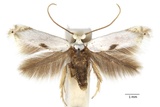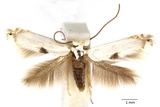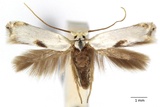Pseudopostega auritella (Hübner, [1813]) Species
Last modified: Dec. 16, 2025, 6:17 p.m.
A rare species in Belgium. It was first observed in 1986 at Niel (AN).
Details
- Classification
- Family: Opostegidae > Genus: Pseudopostega > Species: Pseudopostega auritella
- Vernacular names
- Wolfspootoogklepmot (NL), Fent Bent-wing (EN), Wolfstrapp-Augendeckelfalter (DE)
- First mention in Belgium
- De Prins W. 1989. Enkele soorten Microlepidoptera nieuw voor de Belgische fauna (Lepidoptera: Opostegidae, Ochsenheimeriidae, Coleophoridae, Gelechiidae, Cochylidae, Pterophoridae). — Phegea 17(2): 49–52. On page 49 (as Opostega auritella (Hübner, [1813])). view page
- Status
-
Native
Distribution
Imago
This moth has a wingspan of 9–12 mm and is well recognizable due to the large white eye-caps and the white wings. Also, the dark brown spot halfway through the inner margin of the forewings merges into one large dot when the moth rests. The related species O. salaciella lacks this spot.
Bionomics
The biology of this species is insufficiently known. The larva makes a long (ca. 20 cm) but inconspicuous mine in the bark of the stem of Lycopus europeus. In literature, this species was often erroneus associated with Caltha palustris.
Flight periods
The adults have been observed from early June till mid-August.
Observed on
- Host plant (species):
- Lycopus europaeus
The caterpillar of this species lives in Lycopus europeus. The mentions in literature of Caltha palustris are incorrect.
Habitat
Occurs in swampy areas where the host plant can be found.



